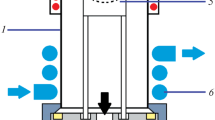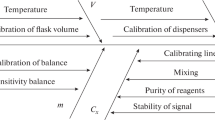Abstract
On-line coupling of inductively coupled plasma (ICP) techniques such as ICP-AES and ICP-MS with ion chromatography (IC) offers unique features for ultra-trace analysis. An on-line preconcentration procedure based on cation exchange enables sub-ng/g analysis in complex matrices like molybdenum and tungsten. The best dissolution reagent for these matrices is hydrogen peroxide, which can be cleaned to ultra high purity with the same metal free chromatography equipment used for the preconcentration. Preconcentration is possible for elements that show cationic reactions within acidic peroxide containing solutions. In this study 28 elements detrimental for microelectronics applications are observed. A comparison of the combinations IC-ICP-AES and IC-ICP-MS with glow discharge mass spectrometry (GDMS) for the analysis of today's purest tungsten samples shows the analytical power and accuracy of the coupled devices. Graphite furnace atomic absorption spectrometry (GFAAS) as an extremely sensitive analytical technique is applied with and without the same sample pretreatment as used for the on-line coupling. Direct GFAAS measurements of alkali metals are complementary to IC-ICP techniques. The data evaluated with these wet chemical techniques are compared to the usual manufacturers characterisation technique GDMS. With respect to the low concentrations present in these high purity materials (ng/g level in the solid) the discrepancies between all methods are acceptable. The sensitivity of IC-ICP-MS is in most cases far superior to IC-ICP-AES and for some elements also to GDMS. Furthermore the specific advantages of on-line coupling such as the elimination of isobaric interferences in ICP-MS or spectral interferences in ICP-AES are shown for ICP-AES and ICP-MS determinations.
Similar content being viewed by others
References
W. W. Harrison,J. Anal. At. Spectrom. 1988,3, 867.
A. P. Mykytiuk, P. Semeniuk, S. Berman,Spectrochim. Acta Rev. 1990,13, 1.
R. Gijbels,Talanta 1990,37, 363.
W. Vieth, J. C. Huneke,Spectrochim. Acta 1991,46B, 137.
M. Grasserbauer,Mikrochim. Acta 1987,I, 291.
H. M. Ortner, W. Blödorn, G. Friedbacher, M. Grasserbauer, V. Krivan, A. Virag, P. Wilhartitz, G. Wünsch,Mikrochim. Acta 1987,I, 233.
W. Blödorn, R. Krismer, H. M. Ortner, J. Stummeyer, P. Wilhartitz, G. Wünsch,Mikrochim. Acta 1989,III, 423.
P. Wilhartitz, H. M. Ortner, R. Krismer, H. Krabichler,Mikrochim. Acta 1990,II, 259.
A. Seubert,Anal. Chim. Acta. 1992,258, 109.
A. Seubert,Fresenius J. Anal. Chem. 1993,345, 547.
G. Wünsch, A. Seubert,Anal. Chim. Acta 1991,254, 45.
Author information
Authors and Affiliations
Rights and permissions
About this article
Cite this article
Seubert, A., Wilhartitz, P., Krismer, R. et al. On-line coupling of ion chromatography and atomic spectrometry and use of direct graphite furnace atomic absorption spectrometry as new tools for ultra trace determinations in refractory metals. Mikrochim Acta 117, 245–260 (1995). https://doi.org/10.1007/BF01244894
Received:
Issue Date:
DOI: https://doi.org/10.1007/BF01244894




